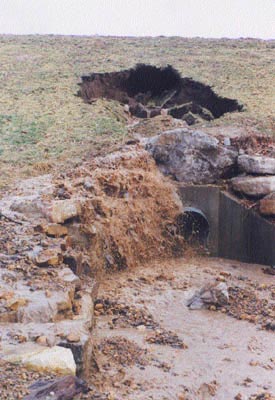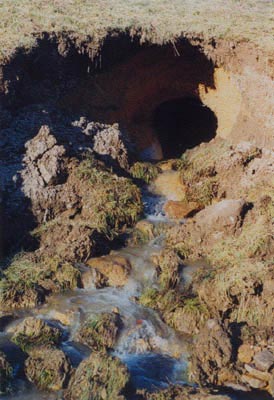The Dam Problem
or what happens when a reconstruction job doesn't go quite right.
Last Update: 27 January 2001
We completed the dam reconstruction at the end of August 1998. Despite a very dry fall the pond slowly filled until finally reaching the overflow in December. As the water level neared the top, a small leak appeared from behind the concrete wing walls of the outlet structure and a small “spring” appeared on the grassy slope on the left wing of the dam. This seepage persisted through all of 1999 but never got worse and may even have diminished somewhat.
|
|
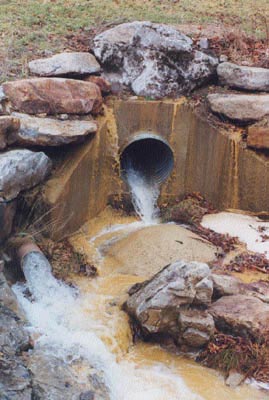 |
We had cold weather from mid-January until mid-February, with several inches of snow on frozen ground. On Valentine’s Day it warmed up and rained 0.6", raising the creek feeding into the pond. Later that day I noticed that the creek below the dam was muddy and found that the seepage had turned into a small stream, perhaps 5 gallons/minute, and it was muddy yellow, carrying out the clay used for the dam core. We've got trouble now! I called Houston Smith, the contractor who had built the dam to come look at it but I could not think of anything to do to stop the flow. |
The next morning (Feb 15) the small stream was a raging torrent with more chunks of dam collapsing into it every few minutes. We set up a siphon with a 4" drain tile to reduce the flow through the gap and ease the rate of erosion. By that evening the water flow had diminished somewhat and clarified.
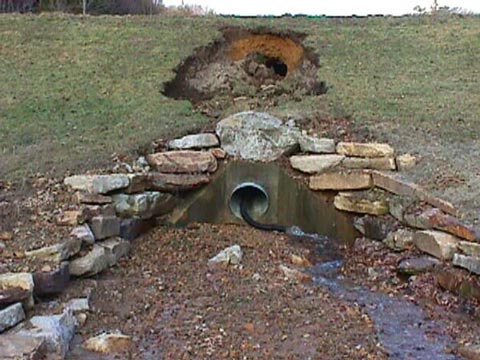
I took more pix on the 16TH. This shows the great hole and the outflow of debris choking the channel below. The siphon hose comes down through the big pipe. The yellowish-red part is the clay core and the black spot below it is a hole all the way through the dam.
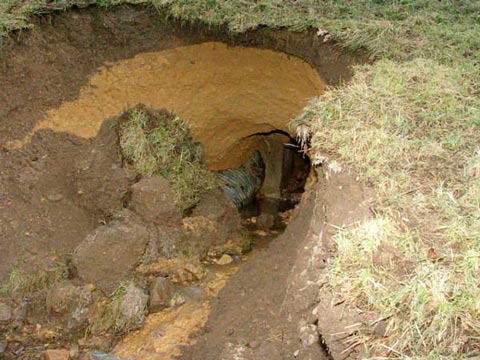
In a closeup of the hole, again on the 16TH, you can see the eroded clay core with topsoil above and falling in. The big pipe can be seen emerging from the concrete block of the intake structure. Apparently water seeped in around the inlet structure, found a weak spot in the core, and once there was enough flow to allow erosion to start it took off like a nuclear chain reaction. The bulk of this hole formed in just a couple of hours!
On the 17TH I took some action to try to prevent a complete washout like we had in ’96. I dug a bunch of clay out of the collapsed section and packed it into the hole next to the inlet structure on the upstream face. I then covered the whole area with a 10' x 20' piece of 6 mil polyethylene and covered that with more clay to hold it in place. The idea is to seal the water away from the leaky part so it cannot increase the washout. So far the siphon pipe is keeping up with the inflow. When inflow increases it can rise up over the plastic sheet and flow into the outlet pipe where it belongs. Or so we hope! That night we had sleet and freezing rain which turned to plain rain during the day. It was fairly light so by afternoon the siphon was still keeping up. That evening the rain picked up in intensity. I was almost afraid to go look. It is asking an awful lot for a sheet of plastic to hold back so much water.... I screwed up my courage and went to look. At 0100 on 19 Feb we had had 1.43" of rain. The pond had risen 3 feet and was flowing over the plastic sheet and into the outlet pipe. There was a very little bit leaking around the plastic. If that does not erode the clay plug I put in by hand it may yet work!
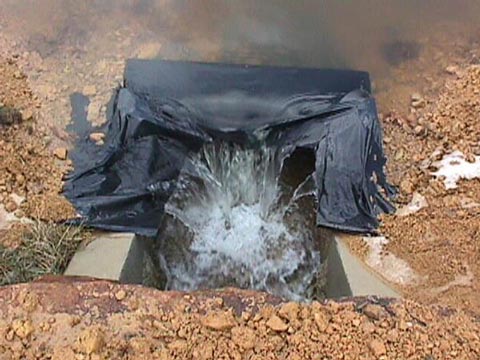
By the morning of the 18TH we had had 1.73" of rain and the patch had held. Looking straight down into the infall of the big pipe we can see the black plastic that extends out 10 feet in all directions and is covered with yellow clay. Water is flowing over it several inches deep but is leaking around it only very little.
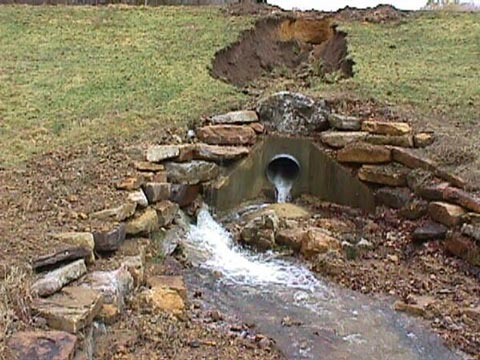
From below we can see the water coming out of the big pipe and the small outlet pipe flowing full but almost no water leaking out around the rocks. Note that some two to three feet of gravel that had washed out with the dam break is now washed away. My thought is to integrate some form of plastic seal into the permanent repair, which can only be undertaken after things dry out. We will reinstall the siphon pipe, washed out by the high water, and try to lower the pond level again.
As of this writing, in January 2001, almost a year has passed and the temporary patch is still in place and holding well. It was so wet throughout 2000 [until October] that we have been unable to draw down the pond to work on it. I bought an 80' by 20' piece of 20 mil landfill liner to replace the 6 mil black plastic. We plan to pack a lot of bentonite [clay sealer] around the outlet box, cover it with the landfill liner, and cover that with a couple of feet of soil. Weather permitting this will be done in May 2001, so that we have the whole growing season ahead of us to get grass growing on the repair.
J R S


Top of this page or go back to the Home Page.

